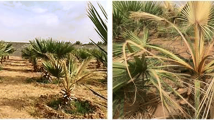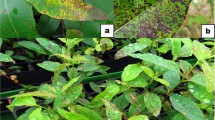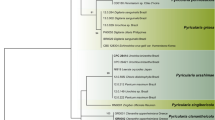Abstract
Isolates of Phytophthora from pepper, produced in Tunisia, were characterised according to molecular and pathogenicity criteria. Polymerase chain reaction amplification of the ITS1 region in the ribosomal DNA resulted in different sized fragments. The pepper isolates and P. nicotianae yielded a fragment of 310 bp that distinguished it from P. capsici with a fragment of 270 bp. The ribosomal RNA gene amplicons of both internal transcribed spacers and the 5.8 S of the pepper Phytophthora and P. nicotianae were digested with 8 endonucleases. The patterns generated, with the 2 enzymes that cut, were identical for both taxa. This molecular analysis corroborated the morphological and biological characteristics and suggests strongly that the isolates of Phytophthora from pepper belong to the species P. nicotianae. Inoculation of pepper, tomato, eggplant and tobacco plants with the isolates of P. nicotianae from pepper showed they were highly pathogenic on pepper but not on tobacco, while their pathogenicity was weak on tomato and eggplant and was associated with atypical symptoms not observed in the field. These pathogenicity tests suggest that pepper isolates of P. nicotianae are particularly adapted to their host and may thus constitute a forma specialis of P. nicotianae.
Similar content being viewed by others
References
Allagui MB, Marquina JT and Mlaïki A (1995) Phytophthora nicotianae var. parasitica pathogène du piment en Tunisie. Agronomie 15: 171-179
Allagui MB and Tello-Marquina J (1996) Phytophthora nicotianae var. parasitica, a pathogen of pepper in Tunisia. Plant Disease 80: 344
Allagui MB and Lepoivre P (1996) Comparaison de différentes techniques d'inoculation du piment par Phytophthora nicotianae var. parasitica. Agronomie 16: 433-440
Anonymous (1976) La défense des cultures en Afrique du Nord, en considérant particulièrement la Tunisie et le Maroc. Solanées: Tomate, Aubergine, Poivron, Pomme de terre. Office allemend de la coopération technique [GTZ], Stuttgarter Strasse, Eschborn
Cooke DEL and Duncan JM (1997) Phylogenetic analysis of Phytophthora species based on ITS1 and ITS2 sequences of the ribosomal RNA gene repeat. Mycological Research 101: 667-677
Crawford AR, Bassam BJ, Drenth A, Maclean DJ and Irwin JAG (1996) Evolutionary relationships among Phytophthora species deduced from rDNA sequence analysis. Mycological Research 100: 437-443
Davet P (1967) Les maladies des solanées maraîchères en Tunisie. Annales de l'Institut National de la Recherche Agronomique de Tunisie 40: 1-43
Doyle JJ and Doyle JL (1990) Isolation of plant DNA from fresh tissue. Focus 12: 13-15
Erwin DC (1964) A strain of Phytophthora parasitica from okra and its sexual compatibility with isolates from citrus. Phytopathology 54: 114-115
Erwin DC and Ribeiro OK (1996) Phytophthora Disease Worldwide. APS Press, St Paul, Minnesota, USA, 562 pp
Faris MA, Sabo FE, Barr DJS and Lin CS (1989) The systematics of Phytophthora sojae and P. megasperma. Canadian Journal of Botany 67: 1442-1447
Förster H, Oudemans P and Coffey MD (1990) Mitochondrial and nuclear DNA diversity within six species of Phytophthora. Experimental Mycology 14: 18-31
Gemawat PD and Prasad N (1964) Further studies on Phytophthora blight of Sesamum. Indian Phytopathology 17: 273-283
Haasis FA (1962) Qualitative and quantitative genetic variation among isolates of Phytophthora parasitica. Phytopathology 52: 12
Hall G (1993) An integrated approach to the analysis of variation in Phytophthora nicotianae and a redescription of the species. Mycological Research 97: 559-574
Kamoun S, Klucher KM, Coffey MD and Tyler BM (1993) A gene encoding a host-specific protein of Phytophthora parasitica. Molecular Plant-Microbe Interactions 6: 573-581
Kannaiyan J, Ribeiro OK, Erwin DC and Nene YL (1980) Phytophthora blight of pigeon pea in India. Mycologia 72: 169-181
Lacourt I, Panabières F, Marais A, Venard P and Ricci P (1994) Intraspecific polymorphism of Phytophthora parasitica revealed by analysis of mitochondrial DNA restriction fragment length polymorphism. Mycological Research 98: 562-568
Lee SB and Taylor JW (1992) Phylogeny of five fungus-like protoctistan Phytophthora species, inferred from the internal transcribed spacers of ribosomal DNA. Molecular Biology and Evolution 9: 636-653
Messiaen CE, Blancard D, Rouxel F and Lafon R (1991) Les maladies des plantes maraîchères (3e ed) INRA, Paris
Moens M and Ben Aïcha B (1982) Possibilités de lutte préventive et curative contre le mildiou du piment Phytophthora capsici (Léon). Med Fac Landbouww Rijksuniv Gent 47: 953-959
Oudemans P and Coffey MD (1991) Relationships between Phytophthora species: evidence from isozyme analysis. In: Lucas JA, Shattock RC, Shaw DS and Cooke LR (eds) Phytophthora (pp 184-203) Cambridge University Press, Cambridge, UK, 447 pp
Panabières F, Marais A, Le Berre JY, Penot I, Fournier D and Ricci P (1995) Characterization of a gene cluster of Phytophthora cryptogea which codes for elicitins, proteins inducing a hypersensitive-like response in tobacco. Molecular Plant-Microbe Interactions 8: 996-1003
Philips DJ and Baker R (1962) Phytophthora crown rot of petunia. Plant Disease Reporter 46: 506-508
Polach FJ and Webster RK (1972) Identification of strains and inheritance of pathogenicity in Phytophthora capsici. Phytopathology 62: 20-26
Ponchet J, Ricci P, Andréolli C and Augé G (1972) Méthodes sélectives d'isolement du Phytophthora nicotianae f. sp. parasitica (Dastur) Waterh. à partir du sol. Annales de Phytopathologie 42: 97-108
Ravisé A (1970) Etude comparative des aptitudes parasitaires de souches de Phytophthora parasites de cultures tropicales. Agronomie Tropicale XXV: 1015-1031
Ricci P, Panabières F, Bonnet P, Maia N, Ponchet M, Devergne JC, Marai A, Cardin L, Milat ML and Blein JP (1993) Proteinaceous elicitors of plant defense responses. In: Legrand M and Fritig B (eds) Mechanisms of Plant Defense Responses (pp 121-135) Kluwer Academic Publishers, Dordrecht, the Netherlands
Satour MM and Butler EE (1967) A root and crown rot of tomato caused by Phytophthora capsici and P. parasitica. Phytopathology 57: 510-515
Tello JC, Vares F and Lacasa A (1991) Analisis de muestras. In: Direccion general de sanidad de la produccion agraria (ed) Manual de laboratorio, diagnostico de hongos, bacterias y nematodos fitopatogenos (pp 39-72) Madrid
Tramier R and Andréolli C (1969) Biologie et écologie du Phytophthora nicotianae f. parasitica (Dastur) Waterhouse parasite du collet de l'oeillet. Ann Phytopathol (n° HS): 171-176
Tsao PH and Ocana G (1969) Selective isolation of species of Phytophthora from natural soils on an improved antibiotic medium. Nature 223: 936-938.
Tucker CM (1931) Taxonomy of the genus Phytophthora de Bary. Res Bull Mo Agric Exp St, 153 pp
White TJ, Bruns T, Lee S and Taylor J (1990) Amplification and direct sequencing of fungal ribosomal RNA genes for phylogenetics. In: Innis MA, Gelfand DH, Sninsky JJ and White TJ (eds) PCR Protocols: A Guide to Methods and Applications (pp 315-322) Academic Press, San Diego
Author information
Authors and Affiliations
Rights and permissions
About this article
Cite this article
Allagui, M.B., Lepoivre, P. Molecular and Pathogenicity Characteristics of Phytophthora nicotianae Responsible for Root Necrosis and Wilting of Pepper (Capsicum annuum L.) in Tunisia. European Journal of Plant Pathology 106, 887–894 (2000). https://doi.org/10.1023/A:1008795700214
Issue Date:
DOI: https://doi.org/10.1023/A:1008795700214




